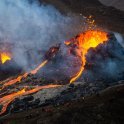Global Risk Perspectives - Monthly insights on geopolitics, trade & climate
Back to articlesNuno Rodrigues

24.01.2022
Volcanic eruptions
Eruption of the Capelinhos volcano
Saturday, September 27, 1958. The Azores Archipelago. The earth had been seizing and convulsing for twelve days; 200 quakes under V on the Mercalli scale had preceded a sudden boiling of the waters at 6h45 that morning, 300m off Ponta dos Capelinhos.
On the three following days, activity increased. Black plumes of volcanic ash reached heights of a thousand metres as a water vapour cloud ascended upwards of four thousand. A few days later, gaseous emissions and pyroclastic blasts somewhat abated, only giving way to violent bursts that birthed lava bombs and spewed volumes of ash into the atmosphere, scorching crops and forcing evacuation of the nearest dwellings even as lava flows oozed out to sea.
The detritus that piled up formed an islet up to 100 metres in height, dubbed Ilha Nova (New Island). When things calmed down, this new structure would be swallowed by the sea. Several other islets emerged and fell to the waves while the volcano remained active.
After seven months of eruption out at sea a crack burst open on land, east side on the volcano’s cone. It spat out red hot magma several metres into the air.
13 months after the original outburst, the volcano’s power dwindled. It breathed its last fires on October 24.
The Capelinhos volcano on the island of Faial (Azores) is the most widely remembered by Azoreans and all the Portuguese, given the destruction it wrought and the number of people who emigrated as a consequence.
The most recent volcanic eruption recorded in the region happened in 1998, however, off Terceira Island, by the parish of Serreta. This underwater eruption caused no damage.
Volcanic activity in the Azores
26 active volcanoes exist on the archipelago, eight of them underwater. Out of the archipelago’s nine islands, Santa Maria alone possesses no active volcano. On the other islands, dormant volcanic structures are present, which may erupt at any moment. There are no other volcanoes on Portuguese territory.
Seismo-volcanic activity in the Azores is monitored by CIVISA — Centro de informação e vigilância sismo-vulcânica dos Açores (Azores Seismo-volcanic Information and Surveillance Centre) and by the Instituto de Investigação em Vulcanologia e Avaliação de Riscos (IVAR — Volcanology and Risk Assessment Research Institute), based on three networks: a seismic one, a gas-measuring geochemical network and a GNSS (Global Navigation Satellite System) network, covering the entirety of the archipelago.
The insurance sector's exposure to volcanic activity
There is no reliable information on what may have been the level of risk transfer to the insurance market for the 1958 Azores volcanic event.
Currently, as Portugal, unlike other European countries, does not possess a Natural Disaster Fund, or one that covers seismic phenomena, even though several attempts were made to create one, the only protection available is through private insurance.
Concerning property insurance markets in Portugal, property damage arising from volcanic eruption typically falls under coverage of seismic phenomena, as are the consequences of such, earthquakes counting among them. Profit losses caused by this kind of natural event may be covered by Loss of Business coverage in conjunction with the simultaneous purchase of coverage for Seismic Phenomena.
Let it be said that in Portugal purchasing cover for Seismic Phenomena is typically optional.
In terms of pricing, it is market practice to settle on a specific rate, developed and recommended by the Portuguese Association of Insurers (APS, Associação Portuguesa de Seguradores), and segmented by area, type of property insured, and construction dates for real property. One should note that no insurer operating in Portugal really retains the lion’s share of seismic exposure (and consequently volcanic exposure) in their portfolios, opting instead to transfer such risk to international reinsurance markets. Tariffs for earthquakes and volcanic eruptions typically hover between 2% to 5% of insured capital per risk location, which means that seismic and volcanic risk cannot be totally transferred to an insurance policy, forcing capital retention onto the insureds themselves.
Regrettably, as already happens with most insurance markets, the coverage gap is rather expressive, exacerbated in Portugal by high levels of insurance illiteracy, undeveloped risk perception (even in the Azores) and weak purchasing power. The latter is worsened by the fact that coverage for earthquakes and volcanic eruptions is considered expensive, i.e., pricier than all other regular coverage on a multi-risk property policy. Note that there is no legal obligation to purchase seismic/volcanic coverage.
Where you have greater exposure, as you do in the Azores archipelago, or wherever older buildings abound, a significant number of insurers tries to downplay seismic and volcanic risk contracts as much as possible, international insurers especially so. Which comes to low penetration numbers for coverage of seismic and volcanic risk, and so a significant protection gap which might be counteracted by the creation of a seismic/volcanic risk fund based on a public-private partnership with mandatory purchase rules.
When you think of Auto insurance, and more specifically Own Damage, you can already cover natural disasters, and that includes volcanic eruptions. This line does present more varied offerings and competitiveness in the national market. The same can be said for Personal Accident cover.
By Nuno Rodrigues, Director Property & Engineering at MDS Portugal



